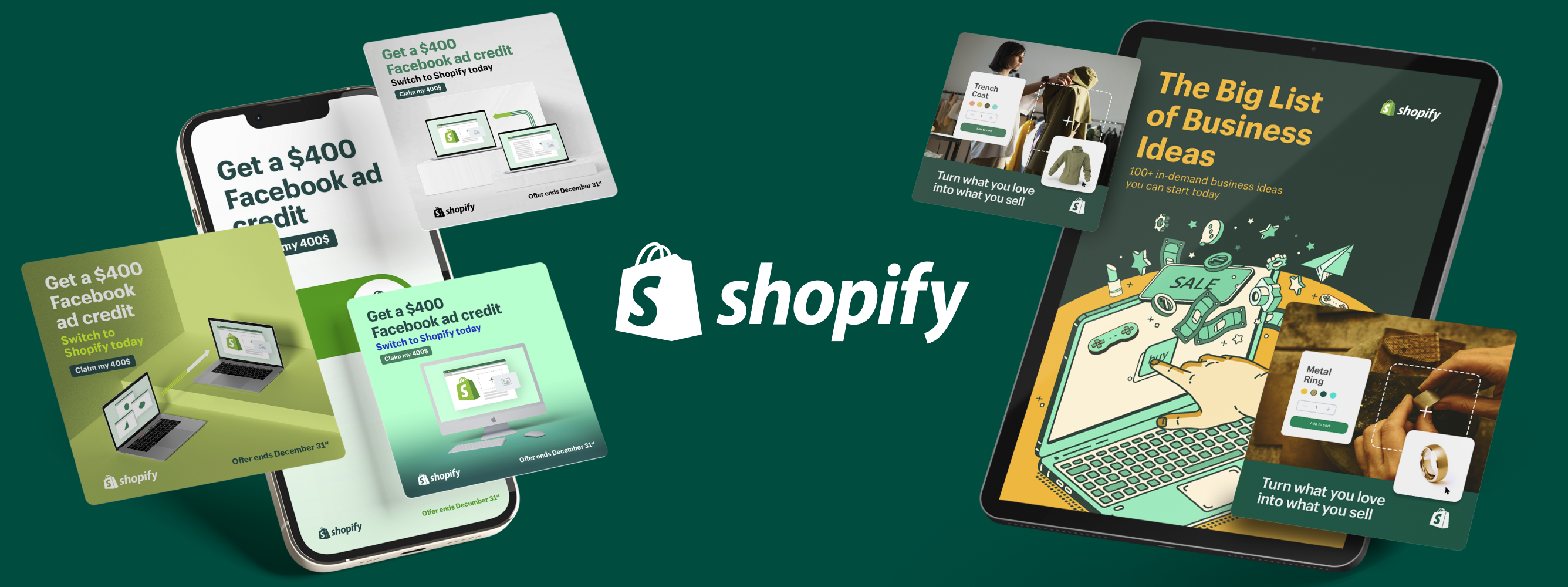Video Marketing Playbook from Shopify's Head of Video Marketing


Video marketing has come a long way in the last few years. From glossy studio productions to scrappier, creator-led content, video marketing isn’t just a passing trend—it also offers incredible ROI.
As a result, marketing teams are increasing budgets, allocating more resources, and doubling down on video production.
But we also know how daunting it can be to get started with video:
- What gear will we need for the level of production we want?
- Who will host and represent our brand?
- Where do we build an audience: Reels, TikTok, or YouTube?
We sat down with one of the best in the video biz, Katie Parkes, a film producer, brand marketer, and the Head of Video Marketing for Shopify's global commercial brands, where she creates some of the best eCommerce video content on the internet.
Katie recently hosted a Gather & Grow session on revenue-driven video marketing, where she showed us how design and marketing could collaborate on your video marketing strategy’s ROI.
You can catch the video on the Superside YouTube channel or keep reading to soak up some of Katie’s wisdom.
Table of contents
- What is video marketing?
- Why video marketing is so powerful
- How to produce different types of marketing videos
- How to create a video marketing strategy
- How to maximize efficiency when creating videos
- How to measure the success of your video marketing
- Katie's Video Marketing Playbook
What is Video Marketing? (and Why Marketers Need to Start)
Video marketing is a digital content strategy that leverages the power of video to attract, engage and convert an audience into prospects or customers.
In the past, marketers defaulted to using video for commercials or as a social-only play with little direct return on investment. Now, businesses turn to video to reach audiences throughout the customer journey, amplify their message across mediums, and create positive brand associations.
In short, video is no longer just for top-of-the-funnel brand awareness campaigns.
When done well, video marketing can drive sales for both B2C and B2B brands.
Video marketing is a couple of tablespoons of digital marketing and social media, mixed with a full cup of traditional content marketing, but in a more exciting format.
Why Video Marketing is So Powerful
Short answer: Because your audience is watching a lot of video.
Here are some quick stats from the video hosting platform for B2B marketers, Wistia:
- When the pandemic started, video uploads jumped from 9 million in 2019 to 17 million in 2020
- From 2019 to 2021, the company saw a 77% increase in annual video plays
- In 2021, they clocked 14.6 billion minutes of video viewed—up from 12.2 billion in 2020
If you’ve ever spent more time than you’d like to admit scrolling on TikTok or catching up on your favorite YouTube channels, you know first-hand how engaging video content can be.
And while the pandemic may have accelerated and expanded online audiences’ appetite for video content, the consumption patterns show no signs of slowing down.
Video is no longer a nice-to-have but a critical part of a successful marketing strategy.
How to Produce Different Types of Marketing Videos
There are so many different types of marketing videos that we made a whole round-up post featuring 15 of them—with examples.
However, while that article covers the ‘what’–in this post, we want to dig into the ‘how.’
COVID’s impact significantly altered how businesses approach video marketing and how audiences engage with it, so before you start producing videos, understand what’s resonating with audiences right now.
Below are a few current video trends that Katie noticed and how her Shopify team responded.
1. Good enough > high quality
Today’s audiences want less polished, more authentic-feeling videos. Especially teens and Gen Z consumers, who stream user-created videos the way previous generations watched TV.
The Shopify YouTube team tried creating content that felt more native to YouTube—think big graphics, messier yet still on-brand design–and the scrappier aesthetic helped some SEO and tech flexing video styles perform better than they had in the past.
2. IRL production for the right moments
Less polished-looking content may be trending, but there’s still a place for slicker productions.
Katie’s advice? Splurge on the campaigns that have the highest potential ROI. For example, Shopify Plus is the company’s enterprise commerce platform for more established brands like Staples, Steve Madden, and Allbirds.
This audience is a huge revenue driver for the company, so it made sense for them to do a slick, gradient-inspired live-action production for their Future of Commerce campaign aimed at this target market.
3. Frankenstein video
Frankenstein videos mix a variety of styles into one video. Since the pandemic made in-person productions difficult, video teams had to get creative, including Shopify’s. Katie’s team produced this three-part behind-the-scenes series with a brand called WkndNation without any live and on-site shoots.
They combined remote interviews and self-produced content from the video subject with existing B roll, social media content, stock footage, slick motion graphics and live-action B roll interviews.
4. Self-produced video
Self-produced or user-generated videos on platforms like TikTok work well and can be done by the brands themselves with a host or staff member or their customers —because people want to learn from other humans. YouTube and TikTok are creator-first platforms, so videos featuring someone explaining a concept or giving a tutorial feel more natural.
The results also speak for themselves. The Shopify YouTube team recently tested using self-produced organic video content on YouTube, and it out-performed agency-produced content.
5. Repurposing formats:
Video content is highly versatile:
- Record your live webinar using a webinar software and post on your YouTube channel
- Cut the webinar into short clips for social media
- Turn a video series into a podcast or a podcast into videos ( In Conversation with Shopify Plus podcast videos)
- Write a blog using the video transcript (like this one!)
- Turn a blog into a video you can tell faster with visuals (Flash Sale hero video content)
Repurposing your video content can help you maximize your production budget and content output and gives you insight into customer behavior. Shopify, for instance, turned their podcast series into YouTube videos, and their total Season 2 listens increased by 500%.
How to create a video marketing strategy that resonates
How do you bring all these exciting videos to life in a way that drives results?
The first thing you need to do is create a video marketing strategy. Here’s Katie’s process:
1. Ask yourself: Why video?
Here are a few questions to consider:
- Does this message, or does this story need to be a video?
- How could it also be repurposed into other formats? How can you connect them?
- How many channels can this video be stretched across to have the highest impact on the business possible?
- How can you use this opportunity to learn more about your audience?
- How does your audience engage with video content across different platforms?
2. Project the ROI.
- Use insights from previous videos to determine potential impact.
- Calculate the potential cost per view, impression, and subscriber. The lower these numbers are, the better.
- Calculate the value of your distribution. What impact could your video have across several channels (e.g., your blog, website, social media, paid marketing)?
- Track the final ROI. And double down on videos that are low cost and high impact.
3. Connect your systems.
- Use a system like Bizible to collect attribution data about the content your customers and potential customers interact with and investigate ways to connect this with your video marketing platform. This step will show how your videos influence your sales and customer journey.
- Work with your marketing automation or technology team to set up Google Data Studio to look at video metrics and insights alongside your blog, social video, and advertising metrics for critical campaigns. Create dashboards that can help you paint a picture and tell the story of your total impact across channels.
4. Leverage retargeting
- Experiment with YouTube ads to build up an audience pool that you can retarget with new ads and campaigns.
How to develop videos for marketing purposes to maximize efficiency
Here’s Katie’s rock-solid marketing video production process to get everyone aligned before you dive in:
- Create a brief. Your brief should:
- Connect your video back to your larger marketing goals,
- Highlight key metrics
- Project ROI
- Acknowledge any roadblocks
- Outline video distribution
- Map out the stakeholders for the project and all of the different layers of ownership.
- Host a kick-off sync. Your kick-off meeting will help you avoid misalignment and clarify what you're trying to achieve, how other teams can help you, and what role they will play.
- Design a treatment or creative deck. This step should help you solidify your project's concept and story.
- Seek input, inspiration, and feedback and align again ahead of production. You want to find harmony between design, performance, and video so that you're making videos that will achieve your goals.
The goals and objectives you need to track for video marketing success
Your goals and objectives may look a little different depending on how you’re leveraging video marketing in your customer journey, but here are a few metrics to keep an eye on:
- Cost per view, impression, and subscriber. To maximize your budget, keep these numbers as low as possible.
- View count. Views don’t always equate to revenue, but they can still help you see which videos your audience likes to watch, which you can then optimize to be more impactful.
- Engagement. How many people engage with your video, from likes to comments and shares? High engagement may not drive conversions, but it can boost the reach of your content. The more people engage, the more others your video shows in feeds.
- Play rate. This metric will tell you how many people took action and clicked play to start watching your video on your website or landing page.
- Watch time. This is the total time people have watched your video, which can help you see if you’ve captured your audience’s attention.
- For example, if a video has a high video count but a low watch time, your video titles and thumbnails draw viewers in, but the content misses the mark.
- Social shares. Social shares will help your video content reach new viewers, which can help you grow your audience, increase brand awareness, and potentially bring in new leads.
- Remember that TOFU video campaigns are typically more shareable than BOFU videos.
- Clicks and click-through rates. If your video has a call-to-action, you should track how many viewers take that next step by tracking clicks and click-through rates.
- Conversions. Last but certainly not least, there are conversions (i.e., leads and sales). This metric is easier to track on ad campaigns, but tracking UTM tags on organic content lets you see which videos impact your bottom line.
Creating your video marketing playbook
We’ve covered a lot of ground in this article, but before you hit the ground running with your video marketing, here are Katie’s final five points to keep in mind:
- Videos perform when we know why we’re making them. Make sure you understand how the video connects to the overarching department and business goals.
- Great videos are created in pre-production. When you produce a video that everyone feels excited about and aligned with, the shoot day is more fun and less a scramble.
- Impactful videos are found across many different channels and touchpoints. Always try to repurpose your videos to maximize reach and visibility.
- Share and integrate your work often and early. Distribution is just as important as the video production itself.
- Your best work is done at the intersection of your craft and discipline. The best video marketing is the perfect blend of art and strategy. Get creative but don’t lose sight of your goals.
And, of course, if you need some extra support on the design front, Superside helps you create attention-grabbing video campaigns that will get your people to like, subscribe, and keep them coming back for more with the help of our video production services.
Cassandra King is the former Head of Content & Community at Superside. She’s a road trip aficionado, advocate for all things glitter, and can usually be found with a camera (or snacks) in hand. Find her on IG @casssandra.king.
You may also like these

15 must-see brand video examples for inspiration (2025)
Video truly has killed the radio star—and pretty much every star there ever was in the world of digital marketing.Businesses that fail to get in on the brand video action are missing an enormous opportunity to tell their brand's story, showcase their products and services creatively, build brand awareness, boost engagement, create an emotional connection with their audience and set themselves apart from the competition.Compelling brand videos can also drive higher conversion rates, ultimately contributing to business growth and success.If you’re in need of a dose of brand video inspiration, you’re in luck. Read on to learn about the power of brand videos, what it takes to make a successful brand video, plus lessons in getting the creative process right with our round-up of some of the best brand video examples out there.The power of brand videos in marketing
7 short-form video trends to maximize impact in 2025
Short-form video’s popularity is skyrocketing. Thanks to the likes of TikTok, Instagram Reels and YouTube Shorts (and our diminishing attention spans), the way people consume media has shifted dramatically. These days, people crave bite-sized, engaging snippets of content that entertain, educate and connect us.Short-form video ticks all these boxes. This is why brands are tapping into the format for its high shareability and potential for rapid audience growth like never before.Ready to ramp up your short-form video content? Our end-to-end video services help enterprise brands with everything from strategy and concept to production and iteration—all while leveraging the benefits of AI whenever it’s a fit.Where should you start? Right here. Explore the seven trends in short-form videos shaping 2025 with Superside's Video Production Director, Ashlee Fitzgerald.The rise of short-form video
Your guide to mastering video at scale for brand growth
Over the last few years, video content has emerged as a critical driver of brand growth. Now more than ever, consumers engage with brands through dynamic, visual storytelling. As a result, scaling video production has become an important goal for enterprises set on hitting a high ROI on their marketing spend.But producing high-quality, consistent video content at scale presents significant challenges, from managing resources to the complexities of creating a cohesive brand narrative across numerous formats, locations and platforms.In this guide, we’ll share the proof you need to get buy-in for scaling video production, provide actionable strategies and tools for growth through video, and go over how the right partnerships (like teaming up with Superside) can help you overcome common challenges when creating video content at scale.Why scaling video production is key to brand growthVideo consumption is growing rapidly worldwide, and it’s easy to see why: Video is dynamic. Instead of looking at a static page, you’re engaging your audience with visuals, audio and motion. Whether your goal is to educate or entertain, video can help get your brand message across in innovative ways.




